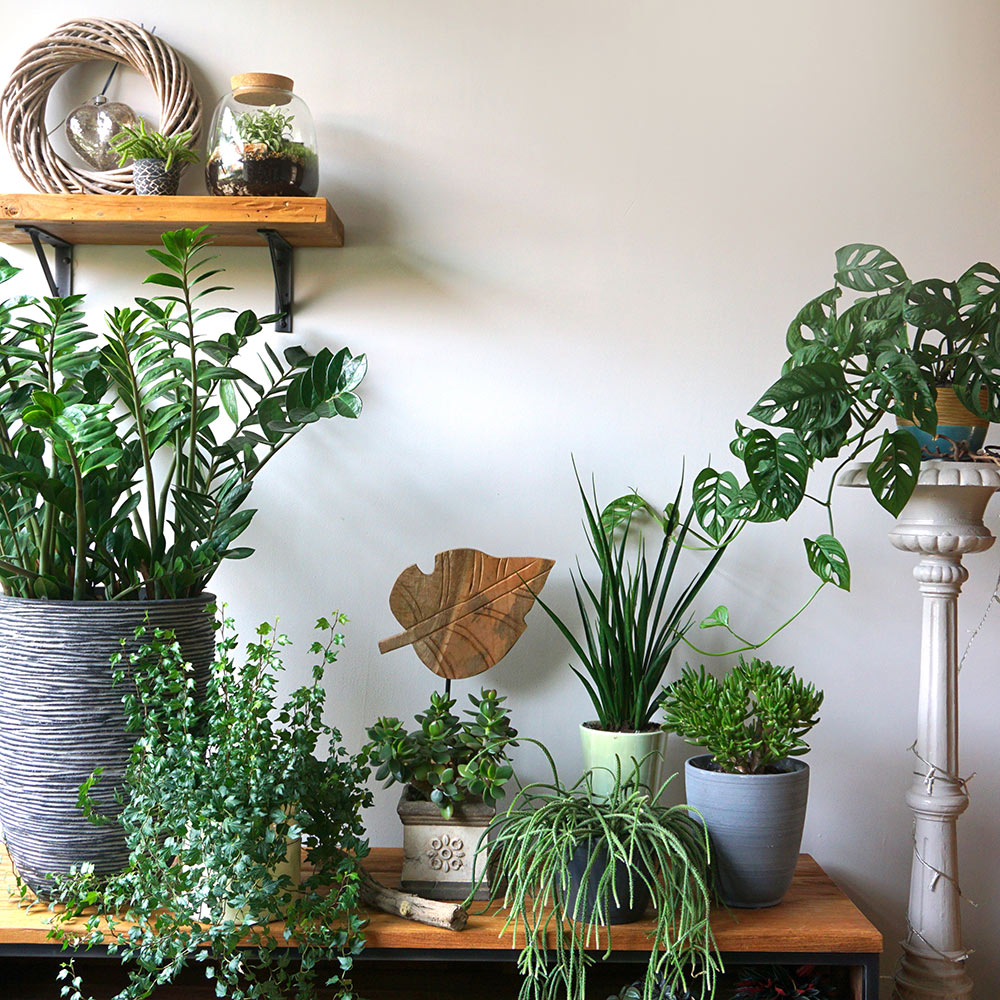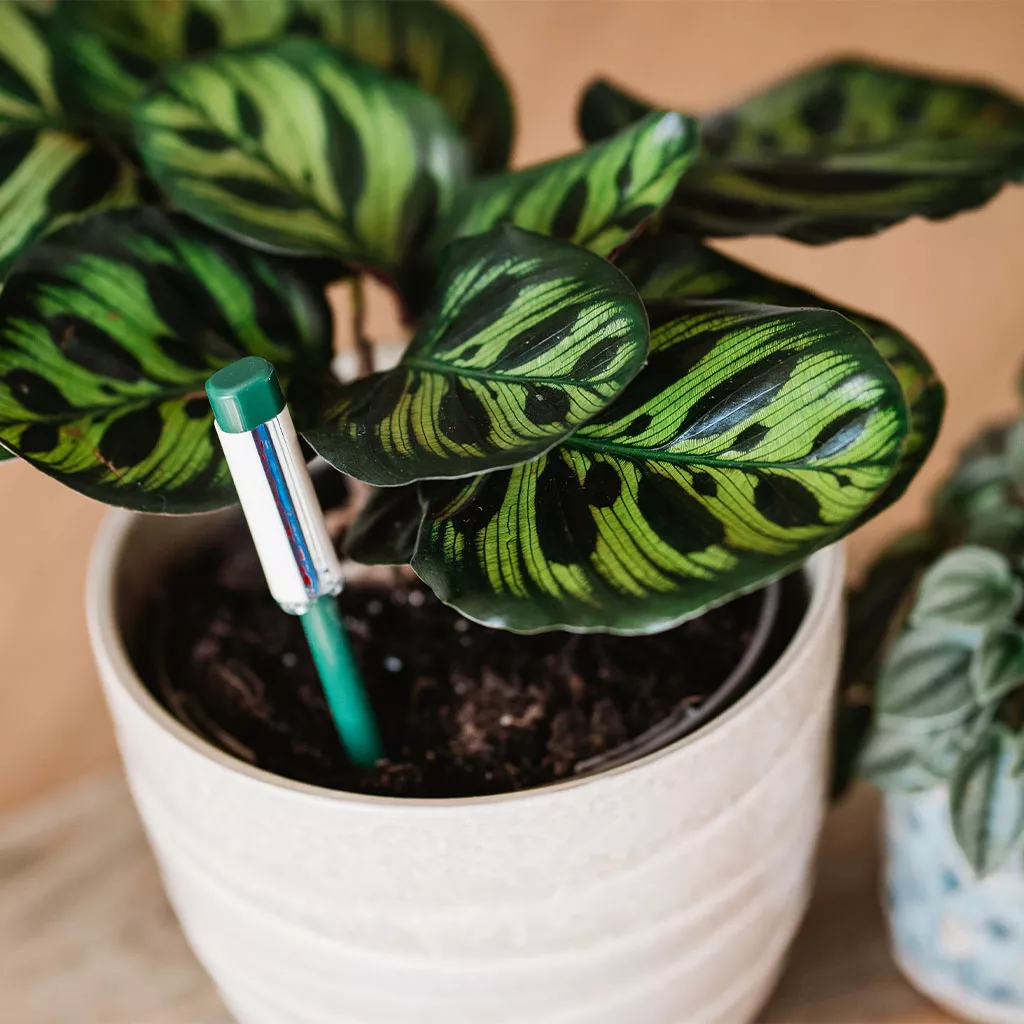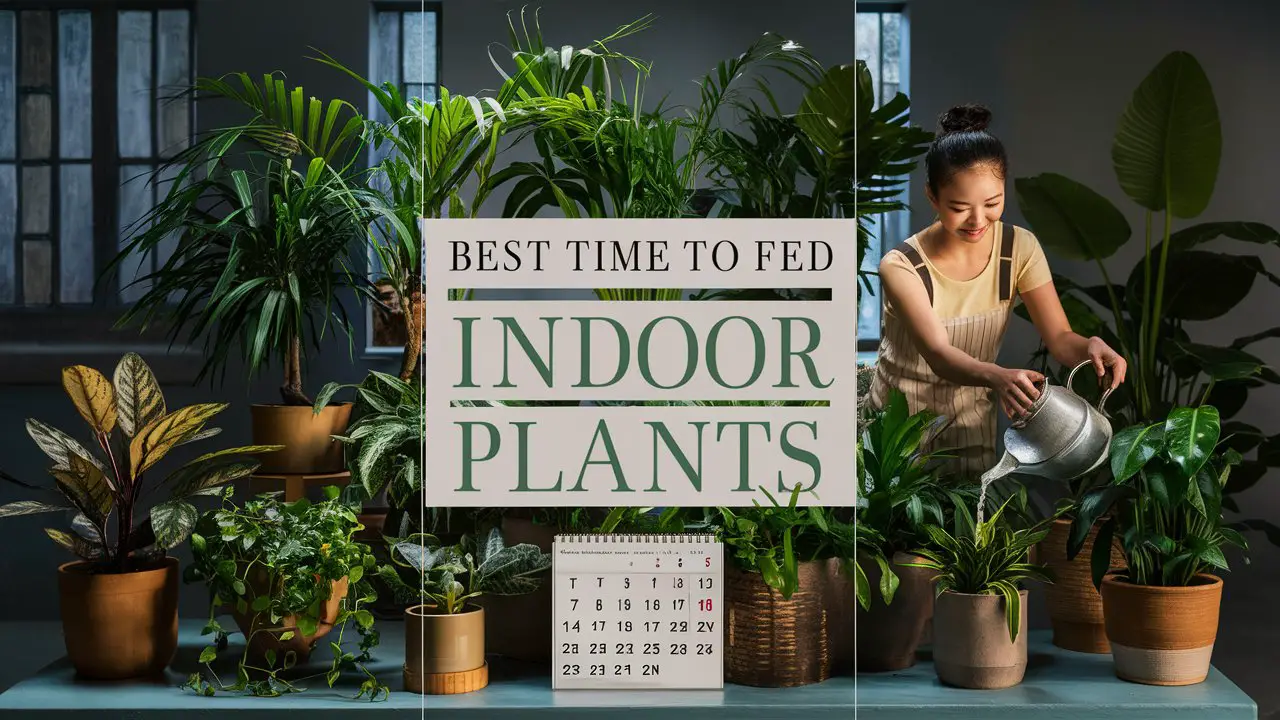The best time to feed indoor plants is during their active growing season, typically from spring to early fall. Avoid feeding during winter dormancy.
Indoor plants need nutrients to thrive, just like outdoor plants. Feeding them during their active growth phase ensures they get the energy required for optimal health. Spring to early fall is when most indoor plants experience rapid growth, making it the ideal period for fertilization.
Use a balanced, water-soluble fertilizer for best results. Follow recommended guidelines to prevent over-fertilization, which can harm plants. Regular feeding during the growing season promotes lush foliage and vibrant blooms. Monitor your plants for signs of nutrient deficiency, such as yellowing leaves, and adjust feeding schedules accordingly. Proper feeding ensures your indoor garden remains lush and healthy year-round.

Credit: www.homedepot.com
The Importance Of Timing In Plant Care
Feeding indoor plants at the right time ensures healthy growth. Proper timing helps plants absorb nutrients effectively. Knowing when to feed your plants can make a big difference.
Balancing Water And Light
Water and light are essential for plant growth. These elements impact nutrient absorption. Ensure your plants receive adequate light before feeding them.
Water your plants regularly. Check the soil moisture before feeding. Overwatering or underwatering can harm your plants.
| Time of Day | Watering Tips | Light Conditions |
|---|---|---|
| Morning | Water lightly | Bright, indirect light |
| Afternoon | Check soil moisture | Filtered light |
| Evening | Avoid watering | Low light |
Growth Cycles And Seasonal Changes
Plants have different growth cycles throughout the year. Understanding these cycles helps in feeding them correctly.
- Spring: Plants grow rapidly. Feed them more often.
- Summer: Growth continues. Maintain regular feeding.
- Fall: Growth slows down. Reduce feeding frequency.
- Winter: Many plants go dormant. Minimal feeding is needed.
Adjust feeding schedules based on seasonal changes. Observe your plants and adapt as needed.
Understanding Your Indoor Plant’s Needs
Feeding your indoor plants at the right time is essential. It helps them grow healthy and strong. To do this, you must understand your plant’s specific needs. Each plant has different requirements. Here, we will break down how to identify those needs.
Identifying Plant Types
Not all indoor plants are the same. Some need more nutrients, others less. Here are some common plant types and their needs:
- Succulents: Need less frequent feeding.
- Foliage Plants: Require regular feeding.
- Flowering Plants: Need balanced nutrients.
- Herbs: Benefit from organic fertilizers.
Knowing your plant type helps you feed them correctly. Use the right fertilizer for each type.
Signs Of Nutritional Needs
Plants show signs when they need food. Look for these signals:
- Yellow Leaves: Indicates lack of nitrogen.
- Poor Growth: May need more phosphorus.
- Pale Leaves: Could be iron deficiency.
- Wilting: Might mean a lack of potassium.
These signs tell you what your plant needs. Adjust the feeding schedule accordingly.
| Plant Type | Feeding Frequency |
|---|---|
| Succulents | Once every 3 months |
| Foliage Plants | Once a month |
| Flowering Plants | Every 2 weeks |
| Herbs | Every 3 weeks |
Regularly check your plants. It helps you keep them healthy. Use these tips to understand your indoor plant’s needs better. Feed them at the right time for best growth.
The Role Of Sunlight
Sunlight plays a crucial role in the health of indoor plants. It affects their growth, photosynthesis, and feeding needs. Understanding the balance between natural and artificial light can help optimize feeding times.
Natural Light Vs Artificial Light
Indoor plants rely on both natural and artificial light. Natural light is the sunlight that enters through windows. It is essential for most plants. Artificial light comes from lamps or bulbs designed for plant growth. Each type of light has unique effects on plants.
| Light Source | Benefits | Drawbacks |
|---|---|---|
| Natural Light |
|
|
| Artificial Light |
|
|
Adjusting Feeding With Light Exposure
Adjust feeding based on light exposure. More light means faster growth. This requires more nutrients. Less light means slower growth. This requires fewer nutrients.
- Observe your plant’s light source.
- Note the duration of light exposure.
- Adjust feeding schedule accordingly.
Feed plants more during longer light periods. Reduce feeding during shorter light periods. Balance feeding to avoid over or under-nourishment.
Seasonal Feeding Strategies
Feeding indoor plants at the right time ensures they stay healthy. Each season brings changes in their growth and nutrient needs. Understanding these can help you provide the best care.
Spring And Summer: Growth Phases
During spring and summer, indoor plants enter their growth phases. They need more nutrients to support this growth. This is the best time to feed them.
Use a balanced fertilizer that provides the essential nutrients like:
- Nitrogen
- Phosphorus
- Potassium
Feed your plants every 2-4 weeks during these months. You can use liquid or slow-release fertilizers. Always follow the instructions on the fertilizer package.
Fall And Winter: Dormancy Considerations
In fall and winter, most indoor plants enter a dormancy period. Their growth slows down, and they need fewer nutrients. Feeding them too much can harm them.
Reduce feeding frequency to once every 6-8 weeks. Use a diluted fertilizer solution. This ensures they get enough nutrients without overfeeding.
| Season | Feeding Frequency | Fertilizer Type |
|---|---|---|
| Spring & Summer | Every 2-4 weeks | Balanced fertilizer |
| Fall & Winter | Every 6-8 weeks | Diluted fertilizer |
Adjusting feeding strategies with the seasons ensures your indoor plants thrive. Pay attention to their needs and provide the right nutrients at the right time.
Watering In Tandem With Feeding
Indoor plants need both water and nutrients to thrive. Feeding them at the right time is crucial. Combining watering and feeding can be beneficial. It ensures your plants get what they need.
The Perfect Water-to-fertilizer Ratio
Finding the perfect water-to-fertilizer ratio is key. Too much fertilizer can harm plants. Too little won’t provide enough nutrients. A balanced mix ensures healthy growth.
- Mix 1 teaspoon of fertilizer with 1 gallon of water.
- Use this solution every two weeks.
- Monitor plant health and adjust as needed.
Avoiding Common Watering Mistakes
Avoid overwatering, which can lead to root rot. Ensure pots have drainage holes. This helps excess water escape.
- Check soil moisture before watering.
- Water plants in the morning.
- Use room-temperature water.
| Common Mistake | Solution |
|---|---|
| Overwatering | Water only when soil is dry. |
| Using cold water | Use room-temperature water. |
| No drainage | Ensure pots have drainage holes. |
Choosing The Right Fertilizer
Choosing the right fertilizer for your indoor plants is crucial. The right fertilizer ensures healthy growth and vibrant foliage. There are many options available, each with its own benefits.
Organic Vs Synthetic Options
When selecting fertilizers, you can choose between organic and synthetic options. Organic fertilizers are made from natural materials. They improve soil health and provide a slow release of nutrients. Synthetic fertilizers are chemically manufactured. They deliver nutrients quickly, but may not improve soil health.
| Type | Benefits | Drawbacks |
|---|---|---|
| Organic |
|
|
| Synthetic |
|
|
Fertilizer Varieties And Their Uses
There are different types of fertilizers, each serving specific needs. Granular fertilizers are easy to use and provide a slow release of nutrients. Liquid fertilizers are fast-acting and good for quick nutrient delivery. Slow-release fertilizers offer a steady supply of nutrients over time.
Consider the following varieties:
- All-purpose fertilizers: Suitable for a wide range of plants.
- Specialty fertilizers: Designed for specific plant types, like succulents or orchids.
- Foliar fertilizers: Applied directly to leaves for quick absorption.
Choosing the right fertilizer ensures your indoor plants thrive. Each variety has unique benefits tailored to plant needs.
Special Considerations For Different Plant Types
Feeding indoor plants is essential for their growth. Each plant type has unique needs. Understanding these needs helps your plants thrive.
Succulents And Cacti
Succulents and cacti require less frequent feeding. They store water and nutrients in their leaves. Feed them once a month during spring and summer. Use a diluted, balanced fertilizer. Avoid feeding them in winter.
Tropical Plants
Tropical plants need more frequent feeding. They grow fast and need more nutrients. Feed them every two weeks during their growing season. Use a balanced, water-soluble fertilizer. Reduce feeding to once a month in winter.
Flowering Plants
Flowering plants need special care during blooming. They require more nutrients to support flower production. Feed them every two weeks with a high-phosphorus fertilizer. Continue this during their blooming period. Reduce feeding after they stop blooming.
| Plant Type | Feeding Frequency | Season | Type of Fertilizer |
|---|---|---|---|
| Succulents and Cacti | Once a Month | Spring and Summer | Diluted, Balanced |
| Tropical Plants | Every Two Weeks | Growing Season | Balanced, Water-Soluble |
| Flowering Plants | Every Two Weeks | Blooming Period | High-Phosphorus |

Credit: www.gardenhealth.com
Monitoring And Adjusting Your Feeding Schedule
Monitoring and adjusting your feeding schedule for indoor plants ensures they get the right nutrients. Too much or too little can harm plant health. Knowing when and how to feed them helps your plants thrive.
Tools For Tracking Plant Health
Using the right tools helps monitor plant health efficiently. Here are some essential tools:
- Moisture meters: These devices check soil moisture levels, preventing overwatering.
- pH testers: Ensure your soil has the right acidity for plant needs.
- Growth journals: Keep notes on your plant’s growth and feeding schedule.
- Light meters: Measure the light your plants receive, ensuring they get enough light.
When To Scale Back Or Increase Feeding
Knowing when to adjust feeding is crucial for plant health. Here are signs to look out for:
| Signs | Action |
|---|---|
| Yellowing leaves | Decrease feeding; check for nutrient burn. |
| Stunted growth | Increase feeding; ensure balanced nutrients. |
| Wilting | Check water levels; adjust feeding accordingly. |
| Healthy, vibrant leaves | Maintain current feeding schedule. |
Adjusting your plant’s feeding based on these signs keeps them healthy. Always use the right tools to monitor plant health accurately.
Frequently Asked Questions
When Should I Give My Plants Plant Food?
Feed your plants every 2-4 weeks during the growing season. Use balanced, water-soluble plant food for best results. Adjust frequency based on plant type and soil conditions. Always follow the instructions on the fertilizer package for optimal growth.
What Month Should I Start Feeding My Houseplants?
Start feeding houseplants in early spring, around March. This is when they begin their active growth phase. Adjust feeding frequency based on plant type and growth rate. Use a balanced, water-soluble fertilizer for best results.
When Should I Fertilize Indoor Plants?
Fertilize indoor plants during their growing season, typically spring and summer. Use a balanced, water-soluble fertilizer every 4-6 weeks. Avoid fertilizing in winter.
What Is The Best Fertilizer For Indoor Plants?
The best fertilizer for indoor plants is a balanced, water-soluble formula with equal parts nitrogen, phosphorus, and potassium. Use every 2-4 weeks.
Conclusion
Feeding indoor plants at the right time ensures their healthy growth. Morning is ideal for optimal nutrient absorption. Regularly monitor soil moisture and plant needs. Adjust feeding schedules based on seasonal changes. Proper care and timing lead to thriving indoor plants, enhancing your home’s greenery and atmosphere.

My mission is to help you bring the beauty of nature indoors with expert advice, detailed plant care guides, and creative design ideas.




